
The brilliant philosopher and mathematician, Gottfied Leibniz, envisioned an infinitely complex world composed entirely of simple psychic units or 'monads’. In this world (our world), everything - all of the way down - is alive. In his Monadology, he writes: “Thus every portion of matter can be conceived as a garden full of plants or as a pond full of fish. But every branch of the plant, every limb of the animal, ever drop of its humors, is again such a garden or such a pond.” I was inspired by Leibniz’s descriptive language and view of nature to create a pond composed of monads - one containing, among other things, a fish within a fish. If it were physically possible to keep drawing ponds within ponds, and fish within fish, to infinity, I would. Alas.

Gottfried Leibniz’s descriptive language and boundless imagination inspired a second pen and ink drawing. In the Monadology, he provides a critique of mechanistic accounts of perception. Perception, he argues, is to be found in the simple substance, not in the complex and interconnected machine: “Suppose that there be a machine, the structure of which produces thinking, feeling, and perceiving; imagine this machine enlarged but preserving the same proportions, so that you could enter it as if it were a mill. This being supposed, you might visit its inside; but what would you observe there? Nothing but parts which push and move each other, and never anything that could explain perception.”

This is a black and white drawing of the illustrious 17th-century philosopher, Rene Descartes. It is superimposed upon a diagram — modeled after one of his own — of the human brain. Descartes is famous for defending substance dualism or the position that the mind and body are separate substances. He believed that the two come together in the pineal gland, the principal seat of the soul.

Study of a specimen at the University at Buffalo Brain Museum
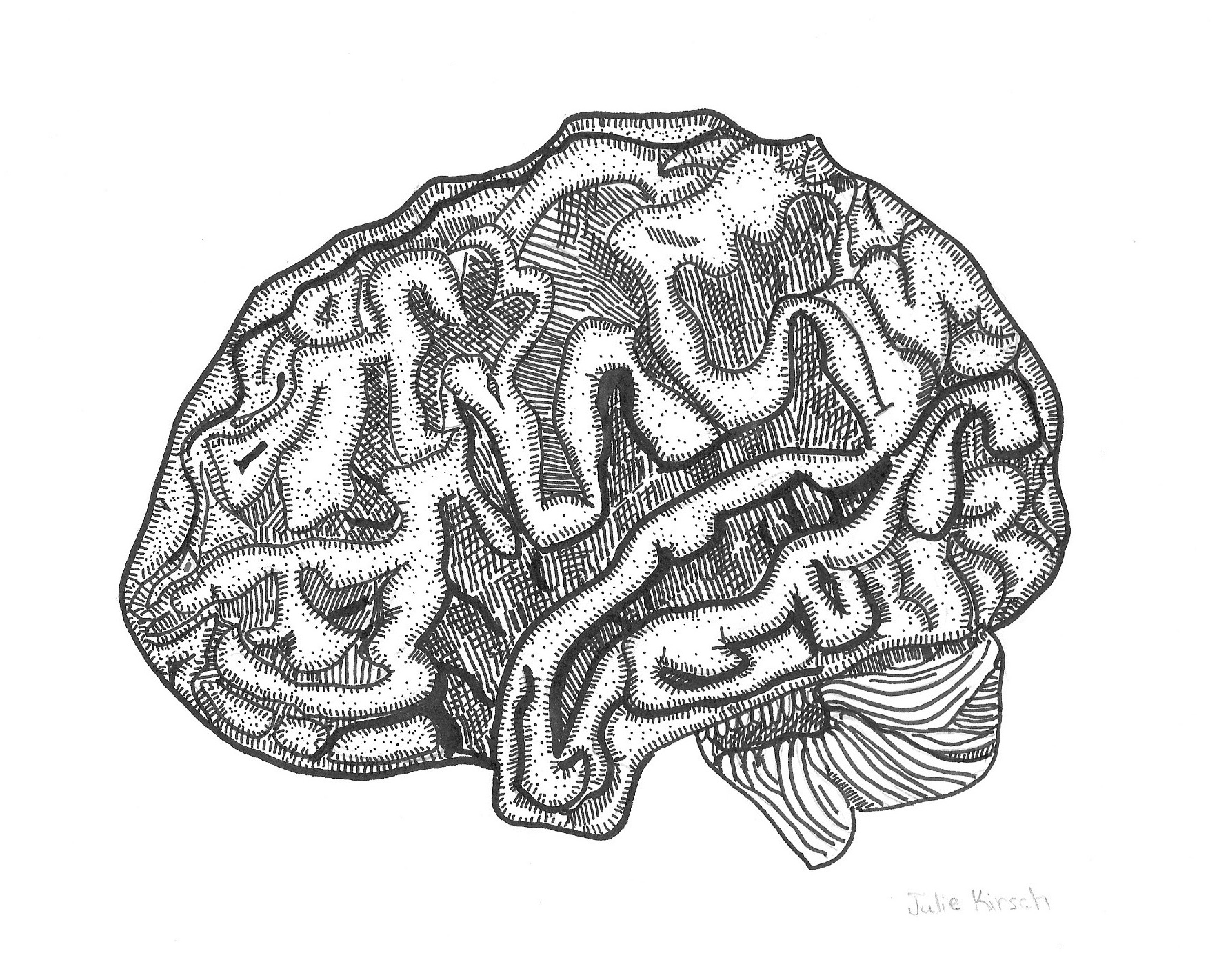
Study of a specimen at the University at Buffalo Brain Museum

Study of a specimen at the University at Buffalo Brain Museum



This oil painting (created in a limited red and green palette) was largely inspired by my interest over the past twenty years or so in the topic of self-deception. Masks are a symbol of deception, fakery, and hidden selves. The black mask in the composition was a gift purchased from the Kensington Market in Toronto. The dramatic shadow that it casts on the left side of the painting is suggestive of something dark and unsettling that is, perhaps, being concealed by the mask.

The human skull, which encloses the brain, is a reminder of our own mortality and limited time on Earth. It is also provides us with an unsettling glimpse of what is hidden beneath our soft skin and emotionally expressive faces. This skull, which I had purchased for a painting setup, broke into pieces under unfortunate circumstances. Upon seeing “my” shattered skull, I exclaimed, “Well, like sucks and then you die” (hence the title of the piece).

Ink on Paper (Available)
My wise mother told me on more than one occasion that the only way to make it through life is by wearing different masks – presenting different selves to the world. This piece picks up on the multiple masks or selves that we reveal to the world. In creating it, I was inspired by several photos that Sktychy muse and performance artist, Janell Del Cid, posted on the Sktchy app. In many ways, social media has enhanced the performative nature of the self; we selectively, deliberately—even artistically – construct a self (or set of selves) to share to the world. And we all know that there is often a conflict or tension between this social media self and the censored self (or the self that we reveal to an intimate few, if any).
All this has me wondering how our solitary COVID-19 quarantine time has affected our sense of self. There is often no one out there to laugh at our jokes, appreciate our witticisms, share our confidences, or forgive our failures. Why don a costume (or work attire), do one’s hair, shave, or wear jewelry if there is no spectator to notice and thereby give reality to this self? Do we lose part of this social self and develop a more robust interior self? Or does the interior self in fact depend upon the observation and affirmation of others?
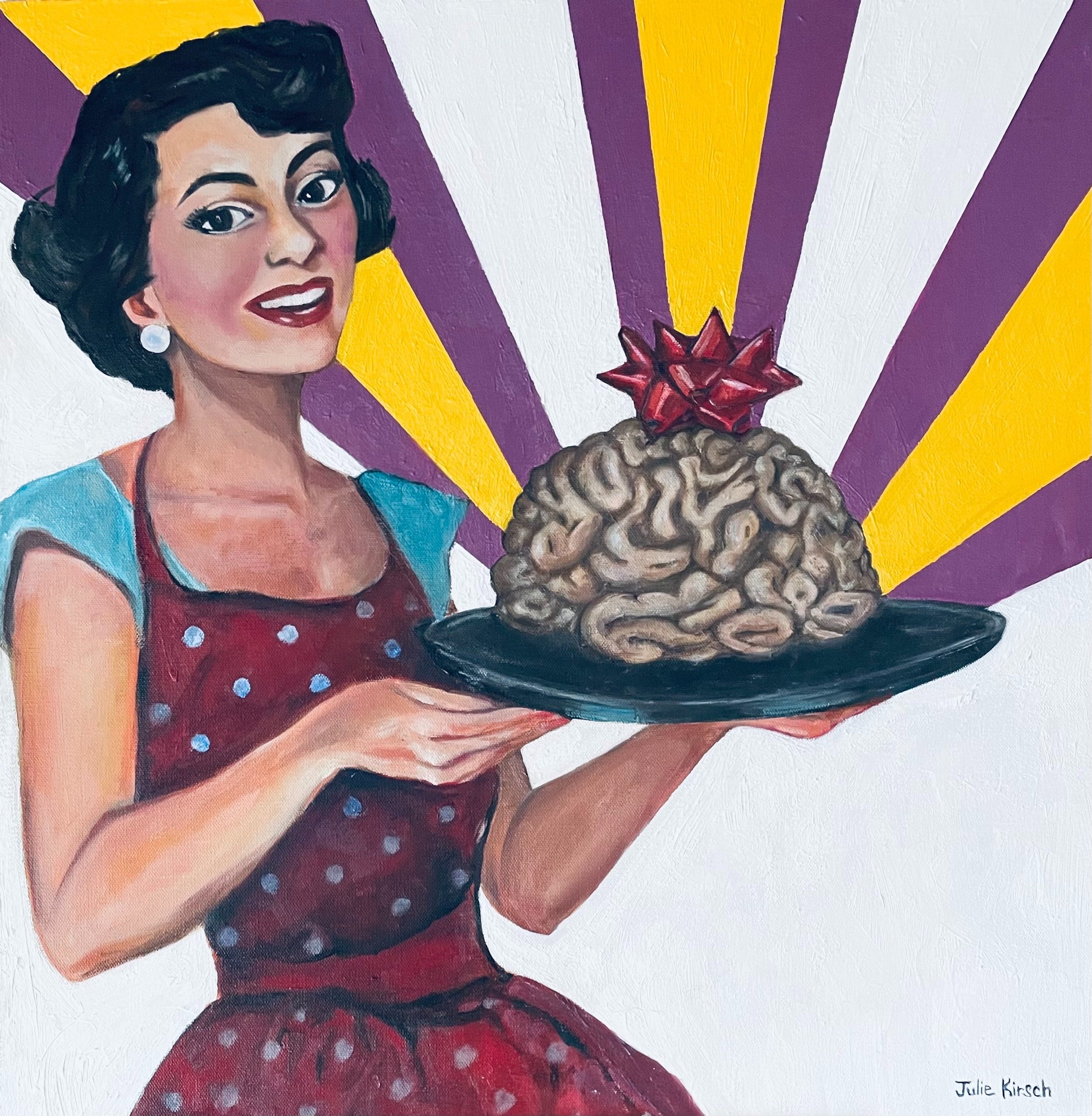
Read the description of this piece on my blog.

Available framed (Print available in my Etsy shop)
This pen and ink explores the way that we can become trapped in our own minds. At times, as the drawing suggests, there may seem to be “no way out.” I used scribbly and jagged lines in this drawing to capture the energy of an overactive central nervous system, or brain riddled by anxiety. The figure in the drawing seems withdrawn and slightly unhinged. Her thoughts, represented by the symbols in the drawing, spiral within her. Although she might ascend the ladders in her mind, there seems to be no escape; she soon slides back down again, ensnared by her mind’s own making.

Available framed (Print available in my Etsy shop)
This pen and ink drawing explores the enigmatic relationship between the physical brain and our experience as conscious selves or persons. Do we as persons grow out of the brain as a tree does from a seed? The title, "Person Seed," is derived from a famous thought experiment in a paper written by Judith Jarvis Thomson. In creating this image, I sketched from images of a famous philosopher. Can you guess which one? And the brain in the drawing is based upon a specimen on display at the University at Buffalo's Brain Museum.
Ink on paper
Available framed
$500
Prints available in my Etsy shop

This piece is based upon a photograph of a brain that I took at the Brain Museum at the University of Buffalo. After providing us with a guided tour of the brains on display, Dr. Chris Cohan (UB professor and curator of the museum) brought out a brain on a tray for us to see and hold. The title of the piece refers to the fact that all of a human being’s mental life is in some way reducible or equivalent to this mysterious, coiled up, clay-like organ. How can this be? This piece was painted alla prima. I wanted to paint the brain in a loose fashion, keeping the paint thick and juicy, using brush stroked to capture the movement and shape of the brain’s gyri and sulci.
Oil on Canvas
Available Framed
$350
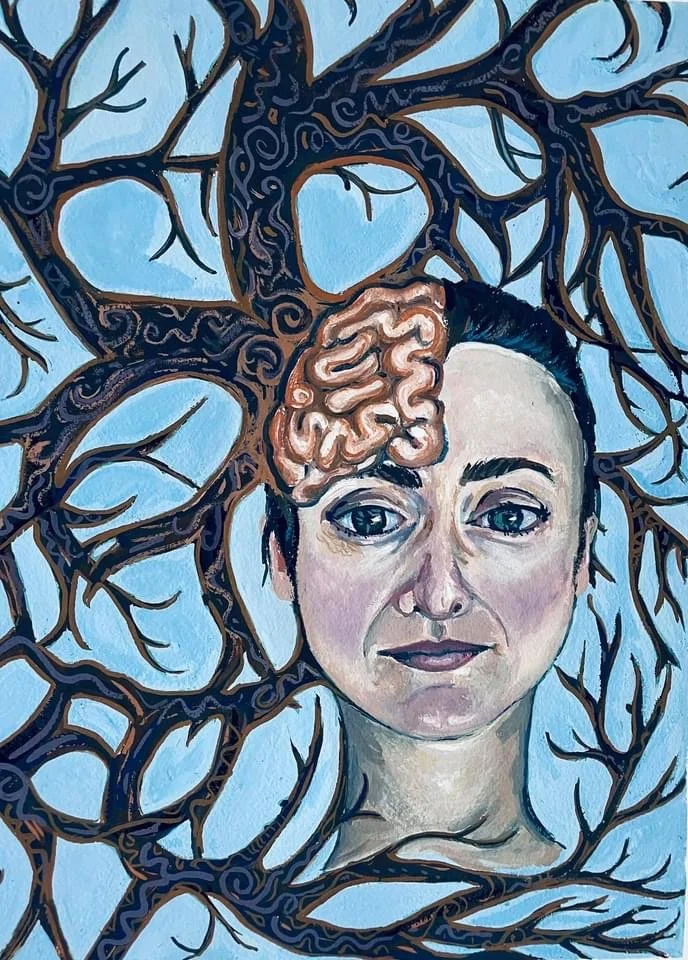
This piece was inspired by a panpsychist view of nature. According to panpsychism, everything in nature is conscious. When we die, the brain decomposes into individual conscious units that are recombined in nature. I tried to illustrate this by painting a twisting and turning tree that literally grows out of the figure’s brain. I used swirling patterns (in the same color as the brain) along the tree branches to signify streams of conscious thought. This piece, and Panpsychist Death, explore similar ideas.
Gouache on paper
Available framed
$500

I love to paint hands because, along with faces, they are suggestive of feelings, moods, and thoughts. They are also delicate and nimble like the human brain. We can use them to create beautiful and complex music on the piano or mandolin, to express love or affection through patterned squeezes, or to call for peace through a simple gesture. In this painting, the figure’s hand is suggestive of thought and introspection, as is the direction of her gaze. Sometimes, as in cases of obsessive or ruminative thinking, our thoughts can form a negative and nearly inextricable loop. At such times, the self, or the brain, may seem to come apart. In the grip of her thoughts, the figure’s brain unravels and fades into darkness.
Oil on Canvas
Available
$250 unframed

I created this piece after reading The Laws of Human Nature, by Robert Greene. I was inspired by Greene’s discussion of the shadow, a term that, in Jungian psychology, refers to the unconscious dark side of human personality. We often try to deny or suppress this aspect of ourselves, which can lead to trouble. With this idea in view, I gave my figure a snake for a brain and filled his abdomen with rats and cockroaches.
Ink on Paper
Available Framed
$350
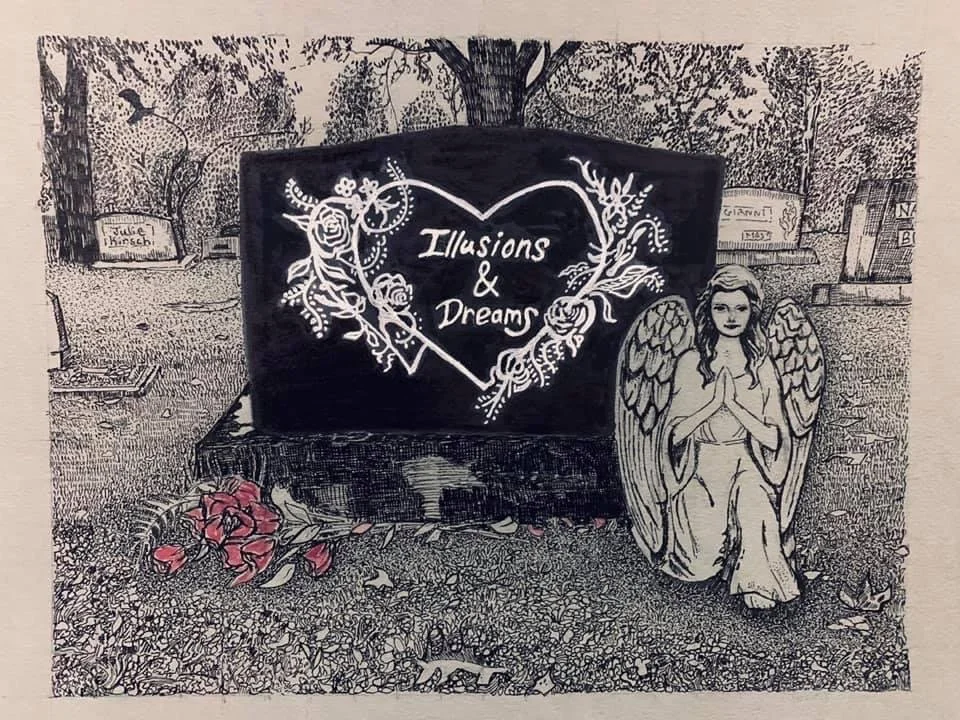
Available
Ink and watercolor on toned paper

“What kinds of brains have radically disunified consciousness? What we are essentially imagining here is the brain of a corpse. For the Panpsychist, there is still consciousness in a dead brain in the sense that each of the fundamental particles making it up is conscious. But in the absence of living, cognitive processes going on within it, the consciousness of the particles is not bound together in a single, unified experience.” - Philip Goff
Ink on paper
Available framed
$500











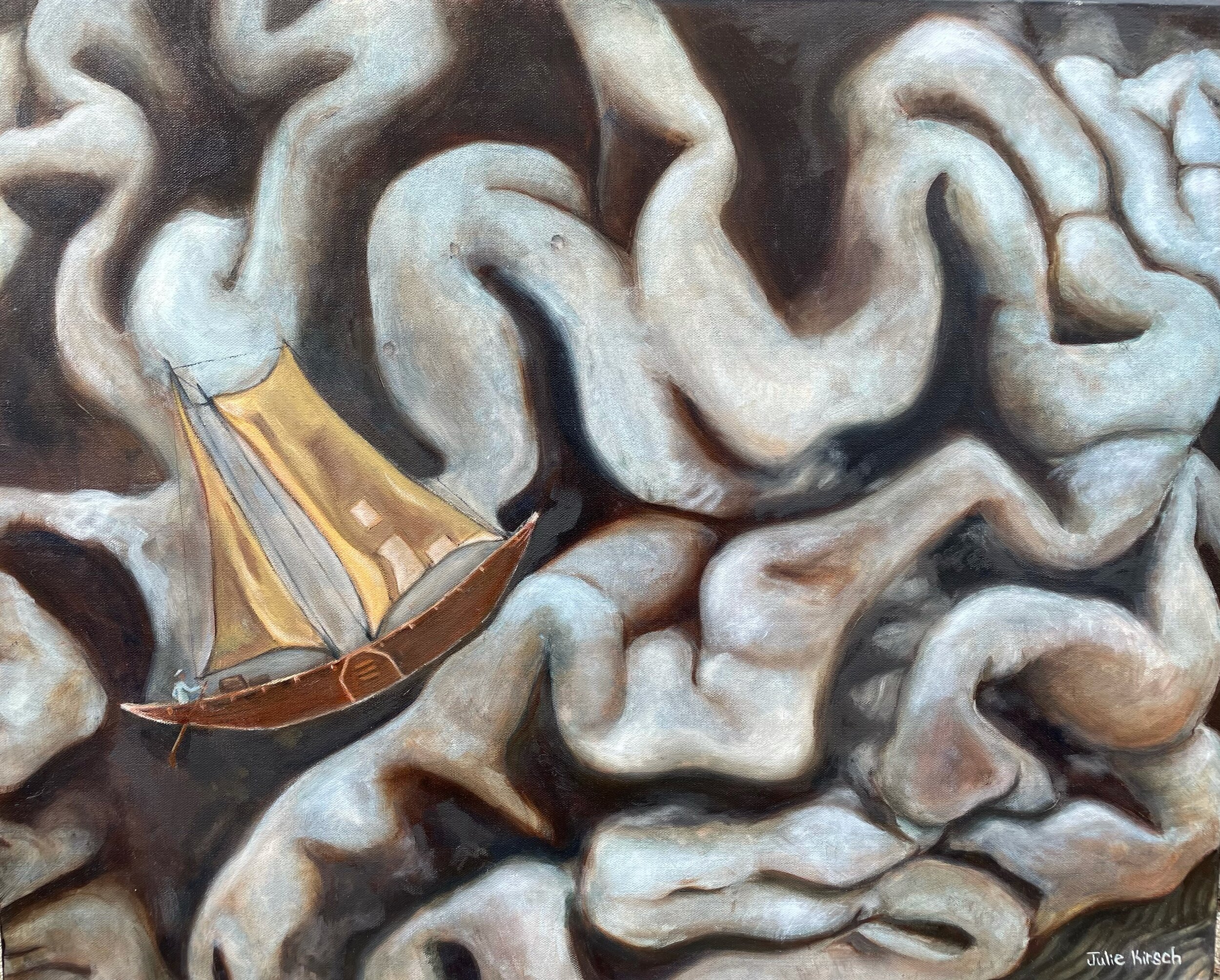











The brilliant philosopher and mathematician, Gottfied Leibniz, envisioned an infinitely complex world composed entirely of simple psychic units or 'monads’. In this world (our world), everything - all of the way down - is alive. In his Monadology, he writes: “Thus every portion of matter can be conceived as a garden full of plants or as a pond full of fish. But every branch of the plant, every limb of the animal, ever drop of its humors, is again such a garden or such a pond.” I was inspired by Leibniz’s descriptive language and view of nature to create a pond composed of monads - one containing, among other things, a fish within a fish. If it were physically possible to keep drawing ponds within ponds, and fish within fish, to infinity, I would. Alas.
Gottfried Leibniz’s descriptive language and boundless imagination inspired a second pen and ink drawing. In the Monadology, he provides a critique of mechanistic accounts of perception. Perception, he argues, is to be found in the simple substance, not in the complex and interconnected machine: “Suppose that there be a machine, the structure of which produces thinking, feeling, and perceiving; imagine this machine enlarged but preserving the same proportions, so that you could enter it as if it were a mill. This being supposed, you might visit its inside; but what would you observe there? Nothing but parts which push and move each other, and never anything that could explain perception.”
This is a black and white drawing of the illustrious 17th-century philosopher, Rene Descartes. It is superimposed upon a diagram — modeled after one of his own — of the human brain. Descartes is famous for defending substance dualism or the position that the mind and body are separate substances. He believed that the two come together in the pineal gland, the principal seat of the soul.
Study of a specimen at the University at Buffalo Brain Museum
Study of a specimen at the University at Buffalo Brain Museum
Study of a specimen at the University at Buffalo Brain Museum
This oil painting (created in a limited red and green palette) was largely inspired by my interest over the past twenty years or so in the topic of self-deception. Masks are a symbol of deception, fakery, and hidden selves. The black mask in the composition was a gift purchased from the Kensington Market in Toronto. The dramatic shadow that it casts on the left side of the painting is suggestive of something dark and unsettling that is, perhaps, being concealed by the mask.
The human skull, which encloses the brain, is a reminder of our own mortality and limited time on Earth. It is also provides us with an unsettling glimpse of what is hidden beneath our soft skin and emotionally expressive faces. This skull, which I had purchased for a painting setup, broke into pieces under unfortunate circumstances. Upon seeing “my” shattered skull, I exclaimed, “Well, like sucks and then you die” (hence the title of the piece).
You can read a description of this piece on my blog.
Ink on Paper (Available)
My wise mother told me on more than one occasion that the only way to make it through life is by wearing different masks – presenting different selves to the world. This piece picks up on the multiple masks or selves that we reveal to the world. In creating it, I was inspired by several photos that Sktychy muse and performance artist, Janell Del Cid, posted on the Sktchy app. In many ways, social media has enhanced the performative nature of the self; we selectively, deliberately—even artistically – construct a self (or set of selves) to share to the world. And we all know that there is often a conflict or tension between this social media self and the censored self (or the self that we reveal to an intimate few, if any).
All this has me wondering how our solitary COVID-19 quarantine time has affected our sense of self. There is often no one out there to laugh at our jokes, appreciate our witticisms, share our confidences, or forgive our failures. Why don a costume (or work attire), do one’s hair, shave, or wear jewelry if there is no spectator to notice and thereby give reality to this self? Do we lose part of this social self and develop a more robust interior self? Or does the interior self in fact depend upon the observation and affirmation of others?
Read the description of this piece on my blog.
Available framed (Print available in my Etsy shop)
This pen and ink explores the way that we can become trapped in our own minds. At times, as the drawing suggests, there may seem to be “no way out.” I used scribbly and jagged lines in this drawing to capture the energy of an overactive central nervous system, or brain riddled by anxiety. The figure in the drawing seems withdrawn and slightly unhinged. Her thoughts, represented by the symbols in the drawing, spiral within her. Although she might ascend the ladders in her mind, there seems to be no escape; she soon slides back down again, ensnared by her mind’s own making.
Available framed (Print available in my Etsy shop)
This pen and ink drawing explores the enigmatic relationship between the physical brain and our experience as conscious selves or persons. Do we as persons grow out of the brain as a tree does from a seed? The title, "Person Seed," is derived from a famous thought experiment in a paper written by Judith Jarvis Thomson. In creating this image, I sketched from images of a famous philosopher. Can you guess which one? And the brain in the drawing is based upon a specimen on display at the University at Buffalo's Brain Museum.
Ink on paper
Available framed
$500
Prints available in my Etsy shop
This piece is based upon a photograph of a brain that I took at the Brain Museum at the University of Buffalo. After providing us with a guided tour of the brains on display, Dr. Chris Cohan (UB professor and curator of the museum) brought out a brain on a tray for us to see and hold. The title of the piece refers to the fact that all of a human being’s mental life is in some way reducible or equivalent to this mysterious, coiled up, clay-like organ. How can this be? This piece was painted alla prima. I wanted to paint the brain in a loose fashion, keeping the paint thick and juicy, using brush stroked to capture the movement and shape of the brain’s gyri and sulci.
Oil on Canvas
Available Framed
$350
This piece was inspired by a panpsychist view of nature. According to panpsychism, everything in nature is conscious. When we die, the brain decomposes into individual conscious units that are recombined in nature. I tried to illustrate this by painting a twisting and turning tree that literally grows out of the figure’s brain. I used swirling patterns (in the same color as the brain) along the tree branches to signify streams of conscious thought. This piece, and Panpsychist Death, explore similar ideas.
Gouache on paper
Available framed
$500
I love to paint hands because, along with faces, they are suggestive of feelings, moods, and thoughts. They are also delicate and nimble like the human brain. We can use them to create beautiful and complex music on the piano or mandolin, to express love or affection through patterned squeezes, or to call for peace through a simple gesture. In this painting, the figure’s hand is suggestive of thought and introspection, as is the direction of her gaze. Sometimes, as in cases of obsessive or ruminative thinking, our thoughts can form a negative and nearly inextricable loop. At such times, the self, or the brain, may seem to come apart. In the grip of her thoughts, the figure’s brain unravels and fades into darkness.
Oil on Canvas
Available
$250 unframed
I created this piece after reading The Laws of Human Nature, by Robert Greene. I was inspired by Greene’s discussion of the shadow, a term that, in Jungian psychology, refers to the unconscious dark side of human personality. We often try to deny or suppress this aspect of ourselves, which can lead to trouble. With this idea in view, I gave my figure a snake for a brain and filled his abdomen with rats and cockroaches.
Ink on Paper
Available Framed
$350
Available
Ink and watercolor on toned paper
“What kinds of brains have radically disunified consciousness? What we are essentially imagining here is the brain of a corpse. For the Panpsychist, there is still consciousness in a dead brain in the sense that each of the fundamental particles making it up is conscious. But in the absence of living, cognitive processes going on within it, the consciousness of the particles is not bound together in a single, unified experience.” - Philip Goff
Ink on paper
Available framed
$500